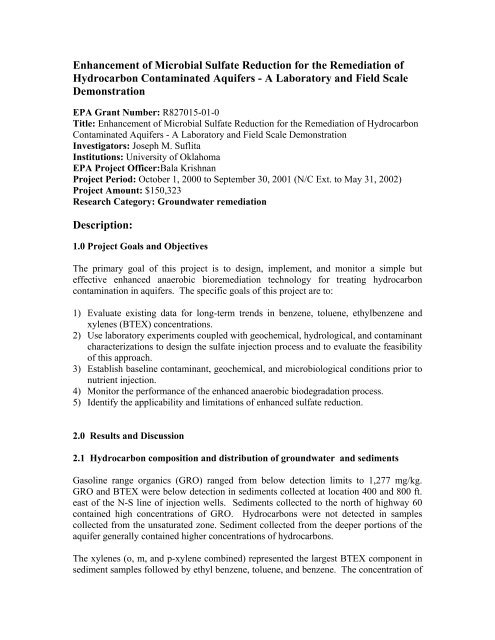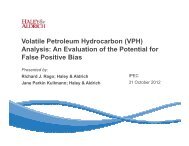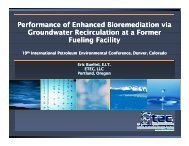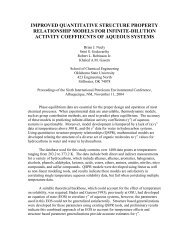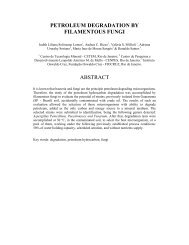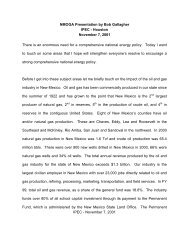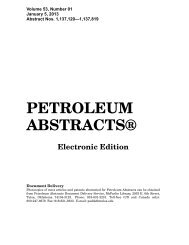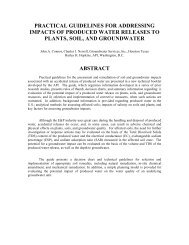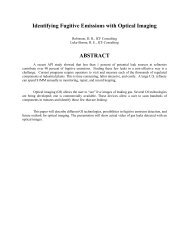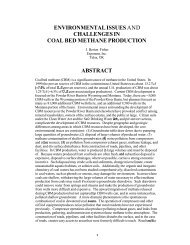First Quarterly Progress Report - IPEC
First Quarterly Progress Report - IPEC
First Quarterly Progress Report - IPEC
Create successful ePaper yourself
Turn your PDF publications into a flip-book with our unique Google optimized e-Paper software.
The high concentrations of methane detected in the aquifer, especially in deeper portionsof the aquifer is consistent with an environment depleted of electron acceptors.Figure 3.Methane vs. BenzeneMethane (mg/L)3025201510500 20 40 60 80Benzene (mg/l)2.5 Anaerobic Benzene Biodegradation With and Without SulfateSediment samples slurried with groundwater collected from roughly the same interval asthe sediments, were amended with sulfate to identify whether sulfate addition stimulatedbenzene biodegradation activity above that detected in incubations that were notsupplemented with sulfate. As seen in figure 4 below, the addition of sulfate stimulatedbenzene biodegradation in many of the samples. The measured rates of benzenebiodegradation ranged from less than one ug benzene/L/d to 37 ug benzene/L/d. Sulfateaddition did not stimulate benzene biodegradation in sediments collected south ofhighway 60 where sulfate was detected in many of the samples. High concentrations ofbenzene (20 mg/L) detected in the SI-12 45-50 sediment slurry did not precludeanaerobic benzene decomposition upon sulfate addition suggesting that benzene toxicitywas not problematic in this sample. Overall, the benzene biodegradation experimentsindicate that the addition of sulfate will stimulate benzene biodegradation in manylocations that are depleted of sulfate.
experiments will be used to identify whether iron sulfide precipitation impacts hydraulicconductivity.Biodegradation experiments and quantification of anaerobic benzene degradingmicroorganismsLaboratory incubations have been prepared with groundwater collected from four wells atthe study site. These samples are being analyzed a variety of microbial activities andnumbers to identify baseline (before sulfate injection) conditions and to evaluate some ofthe factors that may impact benzene biodegradation. The wells will be sampled at a latertime to identify whether the injection of sulfate stimulated the activity and or growth ofanaerobic benzene biodegrading bacteria. The specific analyses that are beingperformed on these water samples include sulfate reduction rates, the number of sulfatereducing bacteria, benzene biodegradation rates, and the number of anaerobic benzenedegrading bacteria with and without sulfate. The benzene biodegradation activity assaysare also being conducted in samples in which hydrocarbons other than benzene have beenremoved from the groundwater to identify whether the presence of complex hydrocarbonmixtures impacts anaerobic benzene biodegradation.Baseline MonitoringGroundwater samples are being collected from approximately 35 wells on a routine basisfor a variety of geochemical and hydrocarbon analyses. These analyses will be used toestablish the baseline conditions to which post-sulfate injection data will be compared.Sulfate Injection SystemThe sulfate injection system has been constructed and will be mobilized to the site withinthe next month.


